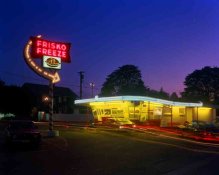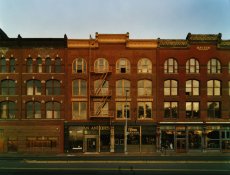I think the qualities that distinguish Hopper's work that are pertinent here are the way that his light glows, and the particular choices he made in his use of color. Some of this is possible in photography; the glow can be emulated. In order to use color as he does, we'd have to choose when and where to shoot; we have different issues today. Hopper wasn't dealing with the multiplicity of light source types that we have today, and since he was a painter, didn't have to deal with spectral anomalies as we do with film.
We don't think of Hopper's use of color and light as "soft", but compared to our contemporary ads in slick magazines, etc. they definitely are. You won't be able to do that with the kinds of lenses they are making for us today. My image "Pacific Avenue" was made with an f/12 Ross WA that has to have been made prior to wwii. I use it because of the warmth it produces and the luminosity of the shadows. It is not a particularly sharp lens, but the images it produces are particularly friendly. I also use old protars (I particularly like the f/18 version), and a Goerz Rectagon. All of these produce a kind of warmth and glow that you just can't get with high end contemporary optics. I also use a super angulon but not for this kind of image. It won't do it.
I'm hoping to compare "Pacific Avenue" with Hopper's "Early Sunday Morning". I don't seem to be able to link to the Hopper file, so here's a url:
http://emptyeasel.com/wp-content/uploads/2007/12/earlysundaymorningbyedwardhopper.jpg
Dang, the uploaded Pacific Ave doesn't seem as warm and vibrant as I expected. In the C print I made from it, and the print film transparency I scanned from, it is much warmer and more saturated.
For awhile, I did a bunch of shooting in the evening and at night. I used 4x5 color negative films, and would choose the film type (daylight vs. B) according to how I wanted the daylight and various light sources to balance. Here, in the Frisko Freeze, you can see how the multiple light source colors influence the color. Hopper didn't have sodium vapor, mercury vapor, fluorescents, etc. to deal with. This image also has that warmth and glow, though. It was made with the f/18 protar.










